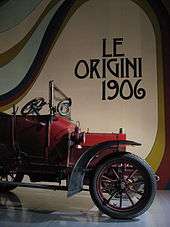Alfa Romeo Spider
| Alfa Romeo Spider | |
|---|---|
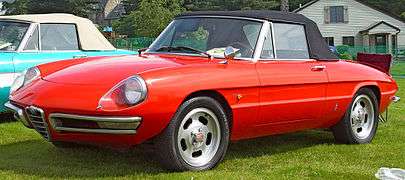 1967 Alfa Romeo Spider 1600 | |
| Overview | |
| Manufacturer | Alfa Romeo |
| Also called | Alfa Romeo "Duetto" |
| Production | 1966–1993 |
| Model years | 1966–1994 |
| Assembly |
Grugliasco, Turin, Italy[1] San Giorgio Canavese, Italy (Pininfarina) |
| Designer | Battista Pininfarina and Franco Martinengo at Pininfarina[2] |
| Body and chassis | |
| Body style | 2-door roadster |
| Layout | Front-engine, rear-wheel-drive |
| Related |
Alfa Romeo Giulia Alfa Romeo 105/115 Series Coupés |
| Chronology | |
| Predecessor | Alfa Romeo Giulietta Spider |
| Successor | Alfa Romeo Spider (1995) |
The Alfa Romeo Spider (105/115 series) is a roadster produced by the Italian manufacturer Alfa Romeo from 1966 to 1993—with small run of 1994 models for the North American market.[3] The successor to the Giulia Spider, it remained in production for almost three decades with only minor aesthetic and mechanical changes. The first three series were assembled by Pininfarina in Grugliasco and the fourth series in San Giorgio Canavese. The last Spider was produced in April 1993—the last rear wheel drive Alfa Romeo before the Alfa Romeo 8C Competizione of 2007.
In May 2012, Fiat announced an agreement with Mazda, finalized in January 2013,[4] to co-develop a new Spider for 2015 based on the Mazda MX-5 platform.[5] However, a modern interpretation of the Fiat 124 Sport Spider was produced instead.
History
Development
In 1962 Alfa Romeo introduced the new 105-series Giulia, which first complemented and then replaced the 101-series Giulietta. The sport variants of the Giulietta remained on sale for several more years, upgraded to the Giulia's 1.6-litre engine and rebadged Giulia, until analogous variants of the new models were ready.
Thus the Giulietta-based Giulia Spider 1600 and Giulia Spider Veloce were produced from 1962 to 1965 and from 1963 to 1965 respectively.[6] The Alfa Romeo Spider was based on Giulia mechanicals, including its Alfa Romeo twin cam inline-four, independent front and solid axle rear suspension, and unibody construction, incorporating the relatively new principles of crumple zones into the front and rear. Following the evolution the other Giulia sport variants, the Spider was powered by a 1.6 L engine, later received a 1750 cc, then a 1300 cc, and finally a 2000 cc engine. Unlike any other Giulia derivative, it was upgraded and continued to sell through four decades, into the 1990s.
As for its predecessor the Giulietta Spider, the Italian firm of Pininfarina was responsible for the design, manufacturing of the body, as well as final assembly. The 1600 Spider was the last project in which founder Battista Pininfarina was involved.[7][8] Design director of Pininfarina at that time was Franco Martinengo.[9]
Design
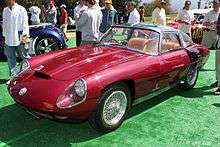
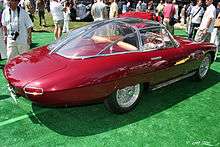
The original 1966 Spider shape was the result of a number of Pininfarina design studies, concept cars showing traits incorporated in the final production design.[10] The first one was the Alfa Romeo Superflow, a concept car built upon the chassis of a retired 6C 3000 CM racing car and first show at the 1956 Turin Motor Show.[10] Despite being an aerodynamic coupé with prominent fins on the rear, and a futuristic all-plexiglas greenhouse and front wings, the Superflow already shown the overall body shape of the future Spider and the scallops on the sides. In the following years the Superflow was updated three times into three more different concept cars, namely a Superflow II coupé, then an open-top spider and finally another Superflow IV coupé. The most significant in the Spider's design history was the second, the open-top Alfa Romeo Spider Super Sport, shown at the 1959 Geneva Motor Show.[10] It did without the rear fins of the Superflow and Superflow II, showing for the first time the rounded cuttlebone-shaped tail and tail light configuration of the Spider.[10] Last of the Spider's forerunner was the Giulietta Sprint Speciale-based Alfa Romeo Giulietta SS Spider Aerodinamica, which premiered at the 1961 Turin Motor Show.[10][11] It was similar in shape to the production car, but for hideaway headlamps.
Despite the almost final design being ready in 1961, the continuing success of existing models and the economic challenges facing Italy at the time meant that the first pre-launch production Spiders began to emerge from the Pininfarina production line only at the end of 1965.[11]
Series 1 (1966–1969)
| First generation | |
|---|---|
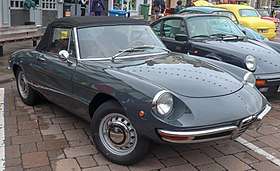 1969 Alfa Romeo 1750 Spider Veloce | |
| Overview | |
| Production | 1966–1969 |
| Powertrain | |
| Engine | |
| Transmission | 5-speed manual |
| Dimensions | |
| Wheelbase | 2,250 mm (88.6 in)[12] |
| Length | 4,250 mm (167.3 in) |
| Width | 1,630 mm (64.2 in) |
| Height | 1,290 mm (50.8 in) |
| Kerb weight | 990–1,040 kg (2,183–2,293 lb) |
The Spider was launched at the 36th Geneva Motor Show in March 1966,[7] and together with the Giulia Sprint GT Veloce tested by the press at an event organised in Gardone Riviera.[8] To choose a name for the spider Alfa Romeo announced a write-in competition, offering an example of the new car as a prize.[13] Over 100 thousand ballots were sent in, the great majority from Italy; the winner was Guidobaldo Trionfi, a man from Brescia, who proposed the name "Duetto" (duet).[13] However it could not be officially adopted due to trademark issues, and the car was named simply Alfa Romeo Spider 1600.[13] The Spider's 1,570 cc twin cam engine had dual Weber two-barrel side-draft carburetors, and produced 109 PS DIN (80 kW; 108 hp; or 129 PS SAE). Sparsely fitted inside but including five speed manual transmission, disc brakes 15" wheels fitted with Pirelli Cinturato 155HR15 CA67 tyres.[14] The price on launch in Italy was 2,195,000 lire. In the US the car sold for $3,950 (compared to $3,991 for a Lotus Elan and $2,607 for an MGB).[15] In the UK the car's price was close to a Jaguar E-Type.[16]
In January 1968, in Vietri sul Mare (Salerno), Alfa Romeo introduced the press to its 1750 line of cars, which included the new 1750 Berlina saloon, the Giulia Sprint-based 1750 GT Veloce coupé, and the 1600 Spider-based 1750 Spider Veloce, which replaced the original Spider 1600.[17] All were powered by the same engine, a new 1,779 cc, 118 PS DIN (87 kW; 116 hp; or 132 PS SAE) version of the Alfa Romeo twin cam engine.[17][18] Top speed rose to 190 km/h (118 mph).[17][18] The car did not bear any Spider badging, just a "1750" script below the rear Alfa Romeo badge. During the production run, the front repeater lights were moved ahead of the wheel arches.
While in Europe the 1750 was fitted with two twin horizontal carburettors, starting with model year 1969 models for the North American market had SPICA (Società Pompe Iniezione Cassani & Affini, a subsidiary of Alfa Romeo) mechanical fuel injection.[19] According to Alfa Romeo engine output and performance were unchanged from the carburetted version.[20] Modifications were also made to the suspension, brakes, electrics, 14" wheels and 165HR14 Pirelli Cinturato CA67 tyres, though the car looked effectively the same. Visible differences were limited to the rear-view mirror repositioned to the door, and badging on the tail, which read "Alfa Romeo" and "iniezione" (injection).
A new lower priced spider, the Spider 1300 Junior, was introduced in June 1968 alongside the GTA 1300 Junior competition coupé.[21] Its 1,290 cc twin cam engine was the same used on the GT 1300 Junior coupé, and produced 89 PS DIN (65 kW; 88 hp; or 103 PS SAE).[21][22] Top speed was 170 km/h (106 mph).[21][22] From a mechanical standpoint the Junior differed from the 1750 only in engine displacement and output, while inside it lacked some features of the pricier model: namely opening quarter lights, centre console, and the three-spoke wood rimmed steering wheel, replaced by a two-spoke plastic rimmed one. From outside the Junior version could be recognised by its black-coloured lower front bumper and absence of plastic headlamp fairings.
Due to the shape of its long, round tail, the Series 1 Spider is sometimes known by the nickname of "Osso di seppia" (Italian for cuttlebone) or "boat tail" to differentiate it from the "Kamm tail" Series 2. In North America the Series 1 is more commonly known as the "dovetail spider".
6,324 1600 Spiders were made and 2,680 1300 Junior.
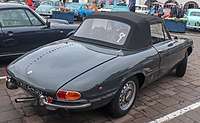
_(14260594357).jpg)
Series 2 (1970–1982/83)
| Second generation | |
|---|---|
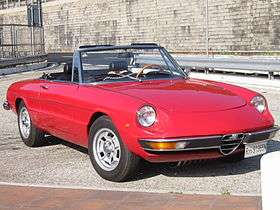 Spider Junior 1.6 (1974) "Coda Tronca" | |
| Overview | |
| Production | 1970–1982 |
| Powertrain | |
| Engine | |
| Transmission | 5-speed manual |
| Dimensions | |
| Wheelbase | 2,250 mm (88.6 in) |
| Length | 4,120 mm (162.2 in) |
| Width | 1,630 mm (64.2 in) |
| Height | 1,290 mm (50.8 in) |
| Kerb weight | 1,025 kg (2,260 lb) |
In 1970 the first significant change to the exterior styling was introduced on the 1750 Spider Veloce, with the original's distinctive elongated round tail revised to a more conventional Kamm tail, improving luggage space. Numerous other small changes took place both inside and out, such as a slightly different grille, new door handles, a more raked windscreen, top-hinged pedals and improved interior trim.
1971 saw the Spider Veloce receive a new, larger powerplant—a 1962 cc, 132 hp (98 kW) unit—and consequently the name was changed from 1750 Spider Veloce to 2000 Spider Veloce. The 1600 Spider restarted production a year later as the Spider 1600 Junior, and was visually identical to the 1300.
1974 saw the introduction of the rare, factory request, Spider-Targa. Based on the Spider, it featured a Porsche style solid rear window and lift out roof panels, all made out of black GRP type material. Less than 2,000 models of such type were ever made and was the only part solid roof Spider until the introduction of the factory crafted hard top.
The 1300 and 2000 cars were modified in 1974 and 1975 respectively to include two small seats behind the front seats, becoming a "two plus two" four seater. The 1300 model was discontinued in 1977. Also, between 1974 and 1976, the early-style stainless-steel bumpers were discontinued and replaced with black, rubber-clad units to meet increasingly stringent North American crash requirements.
4,557 of 1300 Junior were made and 4,848 of 1600 Junior. 16,320 of 2000 Spider Veloce were made and 22,059 of 2000 Spider Veloce US version. 4,027 1750 Spider Veloce were made.
- Series 2 Spider 2000 Veloce
- Spider Coda Tronca
Series 3 (1982/83–1989/90)
| Third generation | |
|---|---|
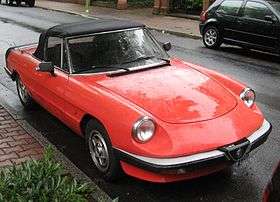 Spider "Aerodinamica" | |
| Overview | |
| Production | 1983–1989 |
| Powertrain | |
| Engine | |
| Transmission | 5-speed manual |
| Dimensions | |
| Wheelbase | 2,250 mm (88.6 in) |
| Length | 4,267 mm (168.0 in) |
| Width | 1,630 mm (64.2 in) |
| Height | 1,290 mm (50.8 in) |
| Kerb weight | 1,040 kg (2,293 lb) |
The Series 3 Spider was previewed in North America for the 1982 model year with the introduction of 2.0 liter Bosch electronic fuel injection to replace the SPICA mechanical injection.
The Spider received a further styling revision in 1983, with introduction of black rubber front and rear bumpers, a front bumper incorporating the grille, a small soft rubber spoiler added to the rear kammback, and various other minor mechanical and aesthetic modifications. The 1600 car (never available in North America) dropped the "Junior" name.
The Quadrifoglio Verde (Green Fourleaf Clover) model was introduced in 1986, with many aesthetic tweaks, including sideskirts, mirrors, new front and rear spoilers, hard rubber trunk mounted spoilers with integral 3rd stoplight, unique 15" alloys and optional removable hardtop. Different interior trim included blood red carpets and gray leather seats with red stitching. QV was offered in only 3 colours: red, silver and black. It was otherwise mechanically identical to the standard Spider Veloce model, with a 2.0 L (1,962 cc) DOHC 2 valves per cylinder four-cylinder engine, fuel fed by twin two-barrel 40DCOM4/5 Weber carburetors in Europe producing 128 PS (126 bhp; 94 kW) at 5400 rpm and 178 N⋅m (131 lbf⋅ft) at 4000 rpm of torque; while in North American models retained the Bosch L-Jetronic fuel injection introduced for the 1982 model year except that the VVT mechanism was now L-Jet activated and five-speed manual transmission.[24][25]
The interior received a new center console, lower dash panels (to meet U.S. regulations) and a single monopod gauge cluster (with electronic gauges). For the North American market a model marketed the Graduate acknowledged the model's appearance in the 1967 film, The Graduate, starring Dustin Hoffman.
The Graduate was intended as a less expensive "entry-level" Alfa. While it had the same engine and transmission as the Quadrifoglio and Veloce, it lacked the alloy wheels and other features. The Graduate model had manual windows, basic vinyl seats, a vinyl top, and steel wheels as standard. Air conditioning and a dealer-installed radio were the only options. It first appeared in 1985 in North America and continued until 1990.
Minor changes occurred from 1986 to 89, including new paint colors, a center high mount stop lamp (CHMSL) midway through 1986 for North American models, a move away from the brown carpet and new turn signal levers. Some 1988 models featured automatic seatbelts that extended from a large device between the front seats.
- Spider Veloce (North America)
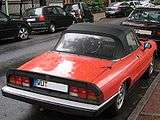 Spider 3rd series
Spider 3rd series- Spider 3rd series Quadrifoglio Verde version with optional hard top
 1987 Spider Quadrifoglio Verde 2.0 hardtop front view
1987 Spider Quadrifoglio Verde 2.0 hardtop front view
Series 4 (1990/91–1993)
| Fourth generation | |
|---|---|
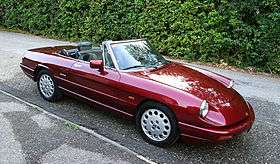 Spider "Type 4" in the rare "Vinaccia Red". | |
| Overview | |
| Production | 1990–1993 |
| Powertrain | |
| Engine | |
| Transmission |
5-speed manual 3-speed automatic |
| Dimensions | |
| Wheelbase | 2,250 mm (88.6 in) |
| Length | 4,257 mm (167.6 in) |
| Width | 1,630 mm (64.2 in) |
| Height | 1,262 mm (49.7 in) |
| Kerb weight | 1,110 kg (2,447 lb) |
The final Spider series, arriving in 1990, included Bosch Motronic electronic fuel injection,[3] full-width body-colored plastic bumper fascias, an electric cooling fan and rear lights across the width of the trunk, on-board diagnostics and an optional automatic transmission. Gone were both front under-bumper and rear trunk-lid spoilers.
In North America, the styling changes did not appear until the 1991 model year; 1990 models featured the Motronic fuel injection but retained the black bumpers. Power steering, larger knee bolsters and a driver-side airbag also appeared as standard for North American market Spiders, which were available in two configurations: Spider and Spider Veloce. The Veloce substituted leather seats for the base model's vinyl; 15" alloy wheels were one size up from the standard steel wheels with hubcaps; and air conditioning and a cloth top were standard.
Production of the original Spider ended in 1993. An all-new Alfa Spider was presented one year later.
For French market a limited and numbered edition was available named Beauté. 120 units were produced in white and navy blue two-tone, with blue hood and white leather seats.
A limited edition Spider Commemorative Edition was produced for the North American market in 1993 and was badged as a 1994 model. Each of the 190 Spider CEs imported to the United States had a small numbered dashboard plaque identifying its place in 190 car series.[3] The CEs differed from previous Spiders in that they had a special badge on the nose, a "CE" script badge below the "Spider Veloce" badge on the tail, unique gold center caps on 15" wheels, and burl wood interior trim. Each model came with a leather portfolio, numbered keychain, and documentation. The cars followed the VIN sequence 008276 to 008460, although there does not appear to be any systematic order numbering. It appears that all of the 1994 Spider Commemorative Editions were produced in May 1993.
In Europe this version was also marketed with 1.6 L engine used in series 3, fitted with Weber 40DCOM4/5 carburettors.[26]
 Spider 4th series side profile
Spider 4th series side profile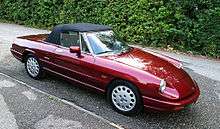 Spider 4th series top closed
Spider 4th series top closed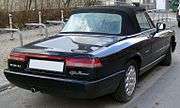 Spider 4th series showing the new rear end
Spider 4th series showing the new rear end
Production
Production of the first generation Alfa Romeo Spider spanned from 1966 to 1993, and amounted to 124,104 cars.
| Year | Units made |
|---|---|
| 1970 | 2,539 |
| 1971 | 3,735 |
| 1972 | 4,121 |
| 1973 | 4,848 |
| 1974 | 5,107 |
| 1975 | 5,189 |
| 1976 | 4,338 |
| 1977 | 4,183 |
| 1978 | 3,868 |
| 1979 | 4,129 |
| 1980 | 5,584 |
| 1981 | 1,653 |
| 1982 | 1,923 |
| 1983 | 5,365 |
| 1984 | 6,587 |
| 1985 | 5,590 |
| 1986 | 7,215 |
| 1987 | 4,339 |
| 1988 | 4,090 |
| 1989 | 3,950 |
| 1990 | 7,106 |
| 1991 | 9,073 |
| 1992 | 3,640 |
| 1993 | 1,956[a] |
| Total 1970–93 | 110,128 |
a 190 examples produced during 1993 were sold as model year 1994 in the United States.
Generations
| Model | Engine | Power | Torque | Years | Production |
|---|---|---|---|---|---|
| Series 1': "Duetto", Osso di Seppia or Roundtail | |||||
| Spider 1600 | 1,570 cc | 109 PS (80 kW; 108 hp) | 142 N⋅m (105 lb⋅ft) | 1966–1967 | 6,324 |
| 1750 Spider Veloce Euro | 1,779 cc | 118 PS (87 kW; 116 hp) | 168 N⋅m (124 lb⋅ft) | 1967–1969 | 2,500 |
| 1750 Spider Veloce US | 1,779 cc | 132 PS (97 kW; 130 hp) | 168 N⋅m (124 lb⋅ft) | 1968–1969 | 2,000 |
| Spider 1300 Junior | 1,290 cc | 89 PS (65 kW; 88 hp) | 137 N⋅m (101 lb⋅ft) | 1968–1969 | 2,680 |
| Series 1 total production: | 13,678 | ||||
| Series 2: Coda Tronca, Fastback, or Kamm tail | |||||
| 1750 Spider Veloce | 1,779 cc | 124 PS (91 kW; 122 hp) | 168 N⋅m (124 lb⋅ft) | 1970–1973 | 4,027 |
| Spider 1300 Junior | 1,290 cc | 89 PS (65 kW; 88 hp) | 137 N⋅m (101 lb⋅ft) | 1970–1977 | 4,557 |
| 2000 Spider Veloce | 1,962 cc | 132 PS (97 kW; 130 hp) | 178 N⋅m (131 lb⋅ft) | 1971–1982 | 38,379a |
| Spider 1600 Junior | 1,570 cc | 110 PS (81 kW; 108 hp) | 137 N⋅m (101 lb⋅ft) | 1972–1981 | 4,848 |
| Series 2 total production: | 51,811 | ||||
| Series 3: Aerodinamica or Duck Tail | |||||
| Spider 2000 | 1,962 cc | 128 PS (94 kW; 126 hp) | 178 N⋅m (131 lb⋅ft) | 1982–1989 | 29,210b |
| Spider 1600 | 1,570 cc | 104 PS (76 kW; 103 hp) | 142 N⋅m (105 lb⋅ft) | 1983–1989 | 5,400 |
| Spider Quadrifoglio Verde | 1,962 cc | 125 PS (92 kW; 123 hp) | 178 N⋅m (131 lb⋅ft) | 1985–1989 | 2,598 |
| Series 3 total production: | 37,208 | ||||
| Series 4: Ultima, Bella or Last | |||||
| Spider 2000 | 1,962 cc | 126 PS (93 kW; 124 hp) | 166 N⋅m (122 lb⋅ft) | 1990–1993 | 18,456 |
| Spider 1600 | 1,570 cc | 109 PS (80 kW; 108 hp) | 137 N⋅m (101 lb⋅ft) | 1990–1992 | 2,951 |
| Series 4 total production: | 21,407 | ||||
In The Graduate
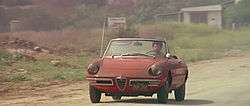
A 1966 Series 1 Spider 1600 is featured in the 1967 film The Graduate,[28] giving the model widespread visibility. A "Graduate" trim level was subsequently marketed in the United States in the 1980s.[29]
Notes
- ↑ "Spider 1600 Duetto". hem.passagen.se. Archived from the original on 21 February 2008. Retrieved 2008-01-23.
- ↑ "Designer". ajovalo.net. Retrieved 2012-02-08.
- 1 2 3 "Affordable Classic: 1991-94 Alfa Romeo Spider 2000". sportscarmarket.com. Archived from the original on 27 June 2007. Retrieved 2007-06-22.
- ↑ "Alfa Romeo, Mazda confirm roadster project". Retrieved 2012-01-18.
- ↑ "Fiat and Mazda announce co-operation program" (PDF). fiatspa.com. 2012. Retrieved 2012-05-23.
- ↑ Fusi (1978), p. 862–864.
- 1 2 "History 1960-1970". alfaromeo.com.au. Archived from the original on 2007-02-19. Retrieved 2007-06-22.
- 1 2 Fusi (1978), p. 627–630.
- ↑ "Design director". tom-tjaarda.net. Retrieved 2012-02-09.
- 1 2 3 4 5 "Alfa Romeo 'spider 1600'". Quattroruote (road test) (in Italian) (136): 116–130. June 1966.
- 1 2 Garnier, Peter, ed. (27 April 1972). "Used Car Test: 1968 Alfa Romeo 1750 Spider". Autocar. 136. (3967): 22–23.
- ↑ "1966 Alfa Romeo 1600 Spider Duetto". carfolio.com. Retrieved 2007-10-27.
- 1 2 3 Bonetti, Daniele (29 June 2013). "Nato a Brescia il mito "proibito" del Duetto" [The "forbidden" myth of the Duetto was born in Brescia]. Bresciaoggi (in Italian). Retrieved 24 July 2015.
- ↑ "Pirelli Cinturato ™". cinturato.net. Archived from the original on 31 January 2012. Retrieved 14 February 2017.
- ↑ http://www.nadaguides.com
- ↑ The Encyclopedia of Classic Cars 1945–1975.
- 1 2 3 "Le nuove Alfa Romeo 1750 presentate ieri in Italia" [The new 1750 Alfa Romeos introduced yesterday in Italy]. La Stampa (in Italian). 14 January 1968. p. 10. Retrieved 23 July 2015.
- 1 2 Fusi (1978), pp. 671–674.
- ↑ "Affordable Classic: 1971-81 Alfa Romeo Spider". sportscarmarket.com. Archived from the original on 2007-06-09. Retrieved 2007-06-22.
- ↑ U.S.A. Version—Alfa Romeo 1750 Spider Veloce (supplement to owner's manual). alfa Romeo. 1969.
- 1 2 3 "Spider 1300 e GTA Junior nuove versioni Alfa Romeo" [Spider 1300 and GTA Junior, new Alfa Romeo variants]. La Stampa (in Italian). 29 May 1968. p. 13. Retrieved 23 July 2015.
- 1 2 Fusi (1978), pp. 675–676.
- ↑ Willson, Quentin (1995). The Ultimate Classic Car Book. DK Publishing, Inc. ISBN 0-7894-0159-2.
- ↑ "1986 Alfa Romeo Spider 2.0 Quadrifoglio Verde". automobile-catalog.com. Retrieved June 16, 2018.
- ↑ "1985 Alfa Romeo Spider Veloce". Carfolio.com. 2013-02-28. Retrieved August 6, 2018.
- ↑ Talbott, Jim; Taylor, Stuart. "Series 4 Spider" (PDF). aroc-uk.com. Archived (PDF) from the original on 24 July 2011. Retrieved 2011-06-20.
- ↑ "Produzione complessiva" (PDF). pininfarina.it. Archived from the original (PDF) on 2011-06-05. Retrieved 2007-08-03.
- ↑ "The Graduate, Movie, 1967". imcdb.org. Retrieved 2010-09-15.
- ↑ "1986 Spider Graduate". conceptcarz.com. Retrieved 2010-09-15.
Bibliography
External links
| Wikimedia Commons has media related to Alfa Romeo Spider "Duetto". |
- Alfa Romeo Spider register
- Alfa Romeo Spider at the Internet Movie Cars Database
« previous — Alfa Romeo car timeline, 1950s–1970s — next » | |||||||||||||||||||||||||||||||||
|---|---|---|---|---|---|---|---|---|---|---|---|---|---|---|---|---|---|---|---|---|---|---|---|---|---|---|---|---|---|---|---|---|---|
| Type | 1950s | 1960s | 1970s | ||||||||||||||||||||||||||||||
| 0 | 1 | 2 | 3 | 4 | 5 | 6 | 7 | 8 | 9 | 0 | 1 | 2 | 3 | 4 | 5 | 6 | 7 | 8 | 9 | 0 | 1 | 2 | 3 | 4 | 5 | 6 | 7 | 8 | 9 | ||||
| Small family car | Dauphine | Alfasud | |||||||||||||||||||||||||||||||
| Compact executive car | Giulietta (750/101) | ||||||||||||||||||||||||||||||||
| Giulia | Giulietta (116) | ||||||||||||||||||||||||||||||||
| Executive car | 1750 Berlina | Alfetta | |||||||||||||||||||||||||||||||
| 2000 Berlina | Alfetta 2000 | ||||||||||||||||||||||||||||||||
| 1900 | 2000 | 2600 | Alfa 6 | ||||||||||||||||||||||||||||||
| Coupé | Giulietta Sprint | GT Junior | Alfasud Sprint | ||||||||||||||||||||||||||||||
| Giulia Sprint GT/GT Veloce | Alfetta GT and GTV | ||||||||||||||||||||||||||||||||
| 1900 Sprint | 2000 Sprint | 2600 Sprint | |||||||||||||||||||||||||||||||
| Cabriolet | 1900 L | Giulia GTC | |||||||||||||||||||||||||||||||
| Spider | Giulietta Spider | Spider | |||||||||||||||||||||||||||||||
| 2000 Spider | 2600 Spider | ||||||||||||||||||||||||||||||||
| Roadster | Gran Sport Quattroruote | ||||||||||||||||||||||||||||||||
| Sports car | 6C 2500 | Montreal | |||||||||||||||||||||||||||||||
| 33 Stradale | |||||||||||||||||||||||||||||||||
| Racing car | TZ | GTA | |||||||||||||||||||||||||||||||
| 158/159 | Tipo 33 | 177/ 179 | |||||||||||||||||||||||||||||||
| Off-road | Matta | ||||||||||||||||||||||||||||||||
| LCV | Romeo | Romeo 2 | Romeo 3 | F11/F12/A11/A12 | |||||||||||||||||||||||||||||
| AR8 | |||||||||||||||||||||||||||||||||
| Ownership | IRI | ||||||||||||||||||||||||||||||||
« previous — Alfa Romeo car timeline, 1980s–present | ||||||||||||||||||||||||||||||||||||||||
|---|---|---|---|---|---|---|---|---|---|---|---|---|---|---|---|---|---|---|---|---|---|---|---|---|---|---|---|---|---|---|---|---|---|---|---|---|---|---|---|---|
| Type | 1980s | 1990s | 2000s | 2010s | ||||||||||||||||||||||||||||||||||||
| 0 | 1 | 2 | 3 | 4 | 5 | 6 | 7 | 8 | 9 | 0 | 1 | 2 | 3 | 4 | 5 | 6 | 7 | 8 | 9 | 0 | 1 | 2 | 3 | 4 | 5 | 6 | 7 | 8 | 9 | 0 | 1 | 2 | 3 | 4 | 5 | 6 | 7 | 8 | ||
| Supermini | MiTo | |||||||||||||||||||||||||||||||||||||||
| Small family car | Arna | 145 | ||||||||||||||||||||||||||||||||||||||
| Alfasud | 33 | 146 | 147 | Giulietta (940) | ||||||||||||||||||||||||||||||||||||
| Compact executive car | Giulietta (116) | 75/Milano | 155 | 156 | 159 | Giulia (952) | ||||||||||||||||||||||||||||||||||
| Executive car | Alfetta | 90 | 164 | 166 | ||||||||||||||||||||||||||||||||||||
| Alfa 6 | ||||||||||||||||||||||||||||||||||||||||
| Coupé | Sprint | GT | ||||||||||||||||||||||||||||||||||||||
| GTV and GTV6 | GTV (916) | Brera | ||||||||||||||||||||||||||||||||||||||
| Spider | Spider (105/115) | Spider (916) | Spider (939) | |||||||||||||||||||||||||||||||||||||
| Sports car | SZ | 8C Competizione | 4C | |||||||||||||||||||||||||||||||||||||
| RZ | 8C Spider | 4C Spider | ||||||||||||||||||||||||||||||||||||||
| Crossover SUV | Stelvio | |||||||||||||||||||||||||||||||||||||||
| Racing car | 179/182/183T/ |
GTV, GTV6 | 75 Turbo | SZ Trophy | 155 GTA 155 V6 TI |
GTV Cup | 156 D2/ GTA S2000 |
147 Cup 147 GTA Cup |
||||||||||||||||||||||||||||||||
| LCV | F11/F12/A11/A12 | AR6 | ||||||||||||||||||||||||||||||||||||||
| AR8 | ||||||||||||||||||||||||||||||||||||||||
| Ownership | IRI | Fiat SpA | FCA | |||||||||||||||||||||||||||||||||||||
